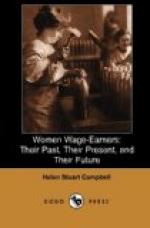Footnote:
[16] Alfred’s History of the Factory Movement, vol. i. p. 27.
IV.
Rise and growth of trades up to the present time.
Defeat and discouragement attend well-nigh every step of the attempt to reach any conclusions regarding women workers in the early years of the century. It is true that 1832 witnessed an attempt at an investigation into their status, but the results were of slight value, actual figures being almost unattainable. The census of 1840 gave more, and that of 1850 showed still larger gain. In that of 1840 the number of women and children in the silk industry was taken; but while the same is true of the later one, there is apparently no record of them in any printed form. The New York State Census for the years 1845 and 1855 gave some space to the work of women and children, but there is nothing of marked value till another decade had passed.
It is to the United States Census for 1860 that we must look for the first really definite statements as to the occupations of women and children. Scattered returns of an earlier date had shown that the percentage of those employed in factories was a steadily increasing one, but in what ratio was considered as unimportant. In fact, statistics of any order had small place, nor was their need seriously felt, save here and there, in the mind of the student.
To comprehend the blankness of this period in all matters relating to social and economic questions, it is necessary to recall the fact that no such needs as those of the mother country pressed upon us. To those who looked below the surface and watched the growing tide of emigration, it was plain that they were, in no distant day, to arise; but for the most part, even for those compelled to severest toil, it was taken for granted that full support was a certainty, and that the men or women who did not earn a comfortable living could blame no one but themselves.
There were other reasons why any enumeration of women workers seemed not only superfluous but undesirable. For the better order, prejudice was still strong enough against all who deviated from custom or tradition to make each new candidate for a living shrink from any publicity that could be avoided. Society frowned upon the woman who dared to strike out in new paths, and thus made them even more thorny than necessity had already done.
It is impossible for the present, with its full freedom of opportunity, to realize, or credit even, the difficulties of the past, or even of a period hardly more than a generation ago. It was of this time that Dr. Emily Blackwell, one of the pioneers in higher work for women, wrote:—




